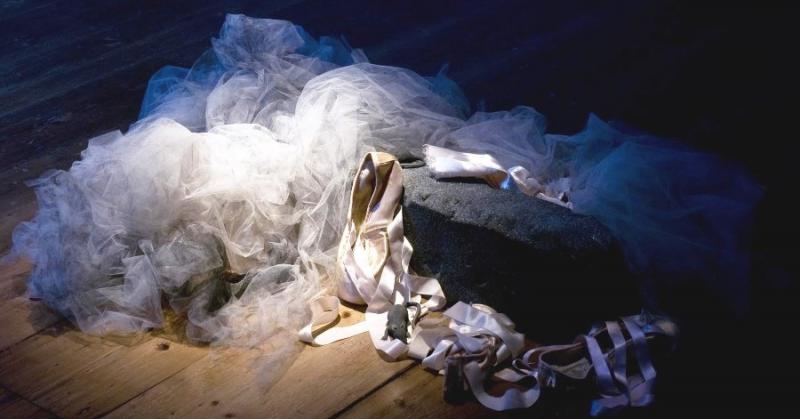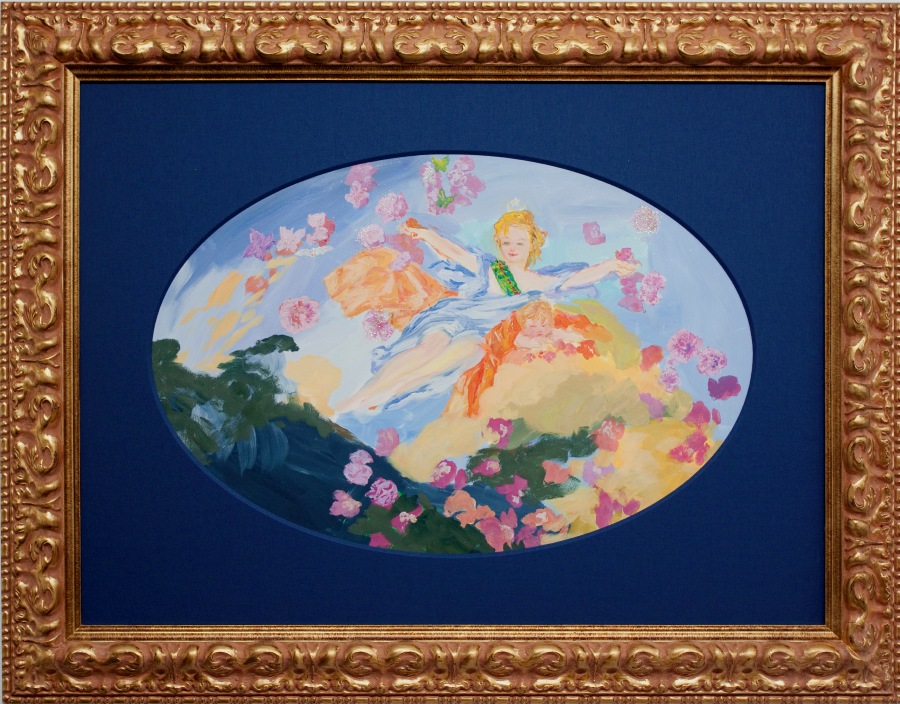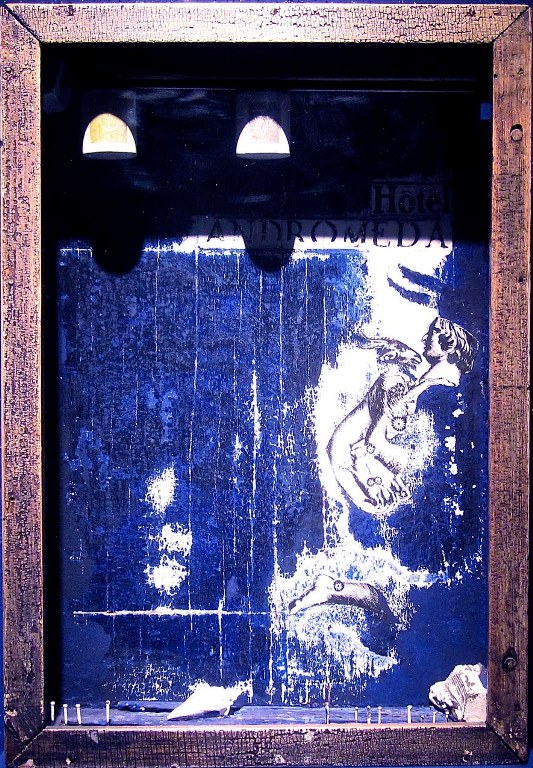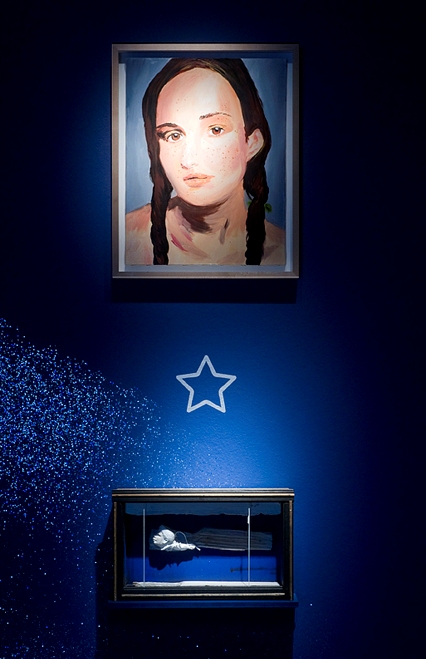Joseph Cornell & Karen Kilimnik, Sprüth Magers London | reviews, news & interviews
Joseph Cornell & Karen Kilimnik, Sprüth Magers London
Joseph Cornell & Karen Kilimnik, Sprüth Magers London
Romance is in the air as celebrated pioneer of assemblages duets with contemporary painter

The gallery has been turned into a little girl’s dressing-up closet. The walls are painted midnight blue and dusted with glitter. Ballet shoes, made for small feet, and a discarded tutu are to be found in a decorous pile on the floor. There are shiny trinkets and princessy things and pictures of ballerinas in bright, pastel shades.
 I’m not quite sure what Joseph Cornell would have made of all this – his quiet, spare, sad little assemblages – those glass-fronted “cabinets" – displayed alongside Karen Kilimnik’s brash, postmodern homages to Degas’ little ballerinas and Boucher’s rococo delights (pictured right: Aurora and Assistants Spreading Happiness and Light; 2009) all accompanied by a piped soundtrack of Swan Lake. But as the celebrated pioneer of assemblages has been dead for almost 40 years, we can’t ask him.
I’m not quite sure what Joseph Cornell would have made of all this – his quiet, spare, sad little assemblages – those glass-fronted “cabinets" – displayed alongside Karen Kilimnik’s brash, postmodern homages to Degas’ little ballerinas and Boucher’s rococo delights (pictured right: Aurora and Assistants Spreading Happiness and Light; 2009) all accompanied by a piped soundtrack of Swan Lake. But as the celebrated pioneer of assemblages has been dead for almost 40 years, we can’t ask him.
We know, however, that Cornell was, like Kilimnik, fascinated by the ballet. He contributed numerous old-fashioned-looking cover designs for issues of a thin little pamphlet called Dance Index and further expressed his appreciation with a series of boxed collages that he called Homage to The Romantic Ballet. And he was a hoarder. His collections of little, discardable treasures were used to make collages and arrangements of bric-a-brac in boxes. Influenced by the Surrealist technique of irrational juxtaposition, these assemblages manage to evoke a feeling of wistful, nostalgic reverie.
 Audiences are fascinated by Cornell because, despite living in New York and being tremendously well-read and cognisant of avant-garde movements, he lived such a closed, isolated life, especially in his latter years. And that makes him a strange and interesting figure, rather in the naïf, outsider mould. He often described himself as “the armchair voyager” and this is an apt description. Through an obsessive collecting of ephemera – postcards, old photos, travel guidebooks, magazine illustrations, etchings and postage stamps – he indeed “travelled” to different eras and fanciful, faraway lands. And rather like a wistful child, he imbued his small objects with representational meaning, so that small white, translucent cubes "became" ballet dancers.
Audiences are fascinated by Cornell because, despite living in New York and being tremendously well-read and cognisant of avant-garde movements, he lived such a closed, isolated life, especially in his latter years. And that makes him a strange and interesting figure, rather in the naïf, outsider mould. He often described himself as “the armchair voyager” and this is an apt description. Through an obsessive collecting of ephemera – postcards, old photos, travel guidebooks, magazine illustrations, etchings and postage stamps – he indeed “travelled” to different eras and fanciful, faraway lands. And rather like a wistful child, he imbued his small objects with representational meaning, so that small white, translucent cubes "became" ballet dancers.
The assemblages shown here aren’t among his best work, but one certainly gets a sense of why people fall for Cornell’s romantic, sweetly melancholic vision. Untitled (Grand Hotel) c 1950, is a wooden box painted white with two wooden “pillars”. Pasted inside is what looks like an Edwardian print of an engraving of a girl’s face – like one of those black and white illustrations advertising soap. And a small ball the size of a large marble. Another, Hotel Andromeda, 1954 (pictured above left), contains small shells and classical Greek marine imagery. Evidently, these are abandoned “ hotels”, past their glory days but retaining the charm of something old and disused.
 American artist Kilimnik wouldn’t be an obvious choice to show alongside Cornell, though they do share a common interest and a fondness for looking back through the eyes of an innocent. Two Americans sharing a kind of uncorrupted, Jamesian vision of the old world, perhaps. But it’s hard to see how they share a similar sensibility, for Kilimnik’s sense of the past borders – one guesses not entirely intentionally – on parody and high camp. Here she “does” Degas, a painting of dancers in a studio, executed not in delicate pastels with a draughtman-like precision, but with expressionistic brushstrokes in bright, acid-pastel colours. Her style hasn’t changed from when she was paying homage to her favourite celebrities Paris Hilton and Hugh Grant, in portraits gleaned from photographs. By contrast, the simplicity of her self-portrait as a young girl, Me, Corner of Haight Ashbury 1966, 1998 (pictured right, with Cornell assemblage), avoids that sense of self-infatuation.
American artist Kilimnik wouldn’t be an obvious choice to show alongside Cornell, though they do share a common interest and a fondness for looking back through the eyes of an innocent. Two Americans sharing a kind of uncorrupted, Jamesian vision of the old world, perhaps. But it’s hard to see how they share a similar sensibility, for Kilimnik’s sense of the past borders – one guesses not entirely intentionally – on parody and high camp. Here she “does” Degas, a painting of dancers in a studio, executed not in delicate pastels with a draughtman-like precision, but with expressionistic brushstrokes in bright, acid-pastel colours. Her style hasn’t changed from when she was paying homage to her favourite celebrities Paris Hilton and Hugh Grant, in portraits gleaned from photographs. By contrast, the simplicity of her self-portrait as a young girl, Me, Corner of Haight Ashbury 1966, 1998 (pictured right, with Cornell assemblage), avoids that sense of self-infatuation.
Sometimes Kilimnik elaborately frames her paintings, as we see in Aurora, and around these paintings she creates an immersive world of pretty, girlish things (though, if you look carefully you might see plastic rats among the tulle and ballet shoes.) If you’re prepared to abandon your cynicism, there is, in fact, something a little seductive about Kilimnik’s installations.
Kilimnik and Cornell make for an interesting coupling, though perhaps Kilimnik is the more domineering party, in danger of shouting down her quieter, more reflective companion.
Explore topics
Share this article
The future of Arts Journalism
You can stop theartsdesk.com closing!
We urgently need financing to survive. Our fundraising drive has thus far raised £49,000 but we need to reach £100,000 or we will be forced to close. Please contribute here: https://gofund.me/c3f6033d
And if you can forward this information to anyone who might assist, we’d be grateful.

Subscribe to theartsdesk.com
Thank you for continuing to read our work on theartsdesk.com. For unlimited access to every article in its entirety, including our archive of more than 15,000 pieces, we're asking for £5 per month or £40 per year. We feel it's a very good deal, and hope you do too.
To take a subscription now simply click here.
And if you're looking for that extra gift for a friend or family member, why not treat them to a theartsdesk.com gift subscription?
more Visual arts
 'We are bowled over!' Thank you for your messages of love and support
Much-appreciated words of commendation from readers and the cultural community
'We are bowled over!' Thank you for your messages of love and support
Much-appreciated words of commendation from readers and the cultural community
 Lee Miller, Tate Britain review - an extraordinary career that remains an enigma
Fashion photographer, artist or war reporter; will the real Lee Miller please step forward?
Lee Miller, Tate Britain review - an extraordinary career that remains an enigma
Fashion photographer, artist or war reporter; will the real Lee Miller please step forward?
 Kerry James Marshall: The Histories, Royal Academy review - a triumphant celebration of blackness
Room after room of glorious paintings
Kerry James Marshall: The Histories, Royal Academy review - a triumphant celebration of blackness
Room after room of glorious paintings
 Folkestone Triennial 2025 - landscape, seascape, art lovers' escape
Locally rooted festival brings home many but not all global concerns
Folkestone Triennial 2025 - landscape, seascape, art lovers' escape
Locally rooted festival brings home many but not all global concerns
 Sir Brian Clarke (1953-2025) - a personal tribute
Remembering an artist with a gift for the transcendent
Sir Brian Clarke (1953-2025) - a personal tribute
Remembering an artist with a gift for the transcendent
 Emily Kam Kngwarray, Tate Modern review - glimpses of another world
Pictures that are an affirmation of belonging
Emily Kam Kngwarray, Tate Modern review - glimpses of another world
Pictures that are an affirmation of belonging
 Kiefer / Van Gogh, Royal Academy review - a pairing of opposites
Small scale intensity meets large scale melodrama
Kiefer / Van Gogh, Royal Academy review - a pairing of opposites
Small scale intensity meets large scale melodrama
 Jenny Saville: The Anatomy of Painting, National Portrait Gallery review - a protégé losing her way
A brilliant painter in search of a worthwhile subject
Jenny Saville: The Anatomy of Painting, National Portrait Gallery review - a protégé losing her way
A brilliant painter in search of a worthwhile subject
 Abstract Erotic, Courtauld Gallery review - sculpture that is sensuous, funny and subversive
Testing the boundaries of good taste, and winning
Abstract Erotic, Courtauld Gallery review - sculpture that is sensuous, funny and subversive
Testing the boundaries of good taste, and winning
 Edward Burra, Tate Britain review - watercolour made mainstream
Social satire with a nasty bite
Edward Burra, Tate Britain review - watercolour made mainstream
Social satire with a nasty bite
 Ithell Colquhoun, Tate Britain review - revelations of a weird and wonderful world
Emanations from the unconscious
Ithell Colquhoun, Tate Britain review - revelations of a weird and wonderful world
Emanations from the unconscious
 Rachel Jones: Gated Canyons, Dulwich Picture Gallery review - teeth with a real bite
Mouths have never looked so good
Rachel Jones: Gated Canyons, Dulwich Picture Gallery review - teeth with a real bite
Mouths have never looked so good

Add comment